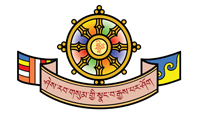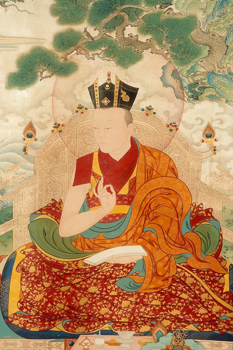31. 12 Karmpa 1703 - 1732
|
“You embody the nonconceptual, great bliss dharmadhatu, and expand the wisdom that knows the profound and luminous non-dual nature. Dispeller of the darkness of ignorance, sole friend of all beings, Changchub Dorje, we supplicate at your feet.”
The Twelfth Gyalwa Karmapa, Changchub Dorje was born at Kyile Tsagto in the province of Derge, East Tibet, just as predicted by the Eleventh Karmapa. His father’s name was Karma Tseten, and his mother’s name was Karmo Kyid. Two months after he was born, the child declared that he was the Karmapa. Tertön Mingyur Rinpoche confirmed the incarnation immediately and told Karma Tseten that one day he would be able to give up his job selling pottery because his son would become one of the greatest masters in all Tibet. Envoys of the Eighth Shamar arrived in Kyile Tsagto, found the boy, and took him to Tsurphu Gon. The Shamar met and recognized him as the reincarnation of the Eleventh Karmapa, his Root Guru. Changchub Dorje was enthroned with the Black Vajra Crown as the Twefth Gyalwa Karmapa at Tsurphu Gon and given all belongings from his past life as well as the entire Mahamudra transmissions and teachings. The young Karmapa then studied under many illustrious masters, also under Sönam Phuntsok.
Changchub Dorje imparted the profound Kagyü Mahamudra teachings to the supreme Nyingma master of Kathok Monastery, who in turn gave the sacred Nyingma Dzogchen teachings that he had received to the Karmapa. A few words about the Kathok Tradition.
The Rangjung Yeshe Dictionary states that there are six principal Nyingma monasteries: Kathok, Pelyül, Dzogchen, Shechen, Mindrolling, and Dorje Drak. The main monastery of Kathok, which is situated in the region of Derge in East Tibet, was founded in 1159. The full name is Kathok Dorje Den because it is built on top of the syllable “GA” that naturally manifested on a smooth, white-coloured stone. Dorje Den is Tibetan for the Sanskrit term Vajrasana, the name of the holiest site of Buddhism in Bodhgaya where Lord Buddha attained enlightenment. Padmasambhava consecrated Kathok thirteen times and said that it was a supreme holy place for the dissemination of the teachings of Yeshe Tsogyal in Tibet. The Rangjung Yeshe Dictionary furthermore writes that “the Kathok Nyingma Lineage is analogous to the essence of the most refined gold. (…) In the centuries of Kathok’s history, there have been a total of 123 accomplished masters. For hundreds of years, the Kathok Nyingmapas had monasteries all over Tibet, Bhutan, India, Sikkim, Mongolia, as well as China. During the ancient times, there were over 300 monasteries but many were in ruins. (…) They (the Khenpos and Rinpoches) are rebuilding many Kathok holy temples, monasteries, Buddhist colleges and meditation retreat centers. In particular, they oversee the reconstruction of the magnificently spectacular holy mandala of the Auspicious Copper-Coloured Mountain, the Pure-land of Padmasambhava, so that it can once again be a holy place for everyone, everywhere.”
The names of the Karmapa’s main students were Tertön Drime Lingpa, Tsuglag Döndrub, Tsuglag Gawa’i Wangpo, Kar-gyüd Trinley Shinta, and Chöyki Jungne, who was the Eighth Tai Situpa and the thirty-third Mahasiddha in the precious beads of the Kagyü Golden Rosary.
A few historical dates: In 1717 the Dzungars occupied Lhasa and killed the Manchu preceptor of Tibet. In 1720 the Chinese Ch’ing emperor drove out the marauding Dzungars from Tibet and established his authority at Lhasa. In 1723 civil war followed the withdrawal of the Chinese; in 1728 Sönam Tobgyä defeated rivals and governed Tibet with Chinese support, while all along Christian missionaries tried to convert everyone to their belief. (See the brief account of the Sixth & Seventh Dalai Lamas following this life-story of His Holiness the Karmapa.)
Together with Tai Situ Rinpoche, Gyaltsap Rinpoche, and Shamar Rinpoche, the Twelfth Gyalwa Karmapa went on a pilgrimage to India and Nepal. The King of Nepal welcomed the Gyalwa Karmapa and his entourage wholeheartedly when they arrived and was very grateful to him for having put a stop to a raging epidemic in his kingdom and for having ended a serious drought by causing rain. They visited the Great Swayambunath Stupa, the Great Boudhanath Stupa, and Namo Buddha, the place where Lord Buddha in a former life had given his flesh as a meal to a starving tigress so that she regained strength and could feed her cubs. Then they went to Kushinagar, the site of Lord Buddha’s Parinirvana.
After Gyalwang Changchub Dorje returned to Tibet, he accepted an invitation to visit the emperor in China and, accompanied by the Shamarpa, started the journey. However, foreseeing further political upheavals in his homeland and realizing that it would be necessary to leave his body, His Holiness wrote a prediction letter and sent it to the Eighth Tai Situpa, informing him about the details of his next incarnation. He succumbed to smallpox at the young age of 29. His Eminence the Eighth Tai Situpa, his spiritual heir, became regent.
“The mighty Buddhas, pondering for many ages, have seen that this (Bodhicitta), and only this, will save the boundless multitudes, and bring them easily to supreme joy.” -- Shantideva
A Brief Account of the Sixth & Seventh Dalai Lamas
In the essay on the Tenth Gyalwa Karmapa, Chöying Dorje, in the series of life-stories of the Mahasiddhas of the Kagyü Golden Rosary presented in this website, we learned that in 1642 the Fifth Dalai Lama was appointed supreme ruler of Tibet by Gushir Khan. The Fifth Dalai Lama established the Tibetan government as it was known in Tibet until it was brutally suppressed when, in 1959, Chinese invaders forced His Holiness the Sixteenth Gyalwa Karmapa, His Holiness the Fourteenth Dalai Lama, hundreds of sages and saints, and millions of Tibetans to flee their homeland. Due to the immense generosity and unfailing kindness of the governments of India, Bhutan, Nepal, and Sikkim and the compassion of the people living in these countries, Tibetan refugees were offered new homes.
The official homepage of His Holiness the Fourteenth Dalai Lama recounts that Desi Sangye Gyatso, who was regent of the Fifth Dalai Lama, Tsangyang Gyatso (1682-1706), and then advisor of the Sixth Dalai Lama, had kept the death of the Fifth Dalai Lama a secret for fifteen years in order to continue building the Potala Palace and complete his other projects. When Mongol princes insisted on having an audience, “an old monk, who resembled the Dalai Lama, was hired to pose in his place. He wore a hat and eyeshadow to conceal the fact that he lacked the Dalai Lama's piercing eyes. The Desi managed to maintain this charade till he heard that a boy in Mon exhibited remarkable abilities. He sent his trusted attendants to the area and in 1688 the boy was brought to Nankartse, a place near Lhasa. There he was educated by teachers appointed by the Desi until 1697, when the Desi sent his trusted minister to the Manchu court to inform Emperor K'ang-si of the death of the Fifth and discovery of the Sixth Dalai Lama. He announced the fact to the people of Tibet, who greeted the news with gratitude and joy and thanked the Desi for saving them from lamenting the setting of the sun and, instead, making them rejoice in its rising. (…) The fourteen-year old was enthroned as the Sixth Dalai Lama in a ceremony attended by Tibetan government officials representing the three major monasteries - Sera, Gaden, and Drepung -, Mongol princes, representatives of Emperor K’ang-si and the Lhasa populace. (…)
The homepage of the Fourteenth Dalai Lama then recounts the life of the Seventh Dalai Lama (1708-1757): “In retrospect, the Tibetan believed that Tsangyang Gyatso predicted his own rebirth at Lithang in Kham when he wrote this song: ‘White crane, lend me your wings, I go no farther than Lithang, And thence, return again.’ Sure enough, the Seventh Dalai Lama was born in 1708 to Sonam Dargya and Lobsang Chotso in Lithang, two years after the disappearance of the Sixth. (…) In 1720, he was enthroned in the Potala Palace and took the novice vows of monkhood from Panchen Lobsang Yeshi, who gave him the name Kelsang Gyatso. In 1726, during the auspicious month of Saka Dawa, he took the Gelong vows (full ordination) from Panchen Rinpoche. He sought the tutor of Panchen Lobsang Yeshi, the Abbot of Gyumey monastery and the Abbot of Shalu monastery, Ngawang Yonten, from whom he studied the entire major Buddhist philosophical treatises and became a master in both the sutra and tantra. In 1751, at the age of forty-three, he constituted the 'Kashag' or council of ministers to administer the Tibetan government and then abolished the post of Desi, as it placed too much power in one man's hand. (…) The Seventh Dalai Lama was a great scholar and wrote many books, especially on the tantra. He was also a great poet who, unlike Tsangyang Gyatso, dwelt on spiritual themes. His simple and unblemished life won him the hearts of all Tibetans.“
“When I see beings oppressed by misdeeds and afflictions, may I hold them dear, as if I had found a rare and precious treasure.” -- His Holiness the Fourteenth Dalai Lama
References: Kagyu Office of His Holiness the 17th Gyalwang Karmapa, Ogyen Trinley Dorje, “The Golden Rosary” (2008). Homepage of His Holiness the 14 th Dalai Lama, “Biographies – The Dalai Lamas - The Sixth & Seventh Dalai Lamas” (2008). Simhanada, “Lineages – The 12 th Karmapa” (2008). Tibetan Buddhist Resource Center , “Biographical Data: The Karmapas,” N.Y. (2008). Rangjung Yeshe Dictionary, “Kat’hok,” in: Rywiki.tsadra.org (2008).
(With sincere gratitude to Khenpo Karma Namgyal for all that he is doing and it is so very much, compiled & written for English-speaking visitors of Karma Lekshey Ling Institute by Gaby Hollmann, apologizing for all inadequacies, Munich, 2008; copyright.) |


